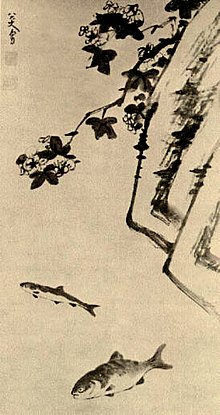Zhu Da
Zhu Da ( Chinese 朱 耷 , Pinyin Zhū Dā , W.-G. Chu Ta ; also known as Bādà Shānrén八大山人 - Pa-ta-shan-jen ; * 1625 in Nanchang ( Jiangxi Province ); † 1705) was a Chinese painter and calligrapher of the Qing Dynasty .
Life
The descendant of the Ming Prince Zhu Quan was considered a child prodigy and began painting and writing poetry from an early age. After the fall of the dynasty in 1644, he fled to a Buddhist monastery at the age of twenty and became a monk. After suffering a nervous breakdown in 1678 , Zhū showed traits of a serious mental illness , which led him in particular to abnormally abrupt alternations between euphoric high spirits and depressionled. One day he wrote the sign "yǎ" (啞; "mute") on his door and from then on did not speak a word, although he continued to laugh, scream and gesticulate. Many of his pictures, which by the way he used to give away, were taken under the influence of alcohol . When making calligraphy, according to a biographer, he usually bared his arm and made animal-like sounds. A short excursion into world life at the end of the 1670s, associated with leaving the monastery and getting married, was only to be short-lived.
plant
Zhū's painting style is characterized by eccentricity . He used to guide the brush - often unevenly wet - slowly and in a twisted motion. Sometimes he applied the ink so moist that it formed blotches that contrast sharply with the dry, brittle brushstrokes that can sometimes be found in the same picture.
His landscapes appear surprisingly modern due to their formal restriction to a few design elements and the avoidance of any depth effect. Zhū's depictions of animals seem puzzling to the viewer : he has alienated the eyes of birds by using square or diamond-like shapes. The animals also often appear human, for example when fish and crows look angrily at the viewer or small fluffy birds exude an utterly beastly aura of self-satisfaction. While some interpreters see the grotesquely skinny legs of Zhū's birds as merely caricatural jokes, others suspect that his depictions of animals conceal criticism of the Manchurian rule by the Qing dynasty .
In the 1930s, the Chinese painter joined Zhang Daqi allegedly by Zhu's hand coming fakes to the public, but because of their softer, more rounded brush stroke were exposed quickly.
literature
- James Cahill : The Chinese painting (= the art treasures of Asia ). Skira, Geneva 1960, OCLC 456625979 .
- Maria Schoiswohl: Bada-Shanren: On political symbolism in the poems of a Ming loyalist. 1987 (dissertation, University of Vienna, 1987).
Web links
| personal data | |
|---|---|
| SURNAME | Zhu Da |
| ALTERNATIVE NAMES | Bādà, Shānrén; Pa-ta-shan-jen; c = 朱 耷 (Chinese) |
| BRIEF DESCRIPTION | Chinese painter and calligrapher of the Qing Dynasty |
| DATE OF BIRTH | 1625 |
| PLACE OF BIRTH | Nanchang |
| DATE OF DEATH | 1705 |
